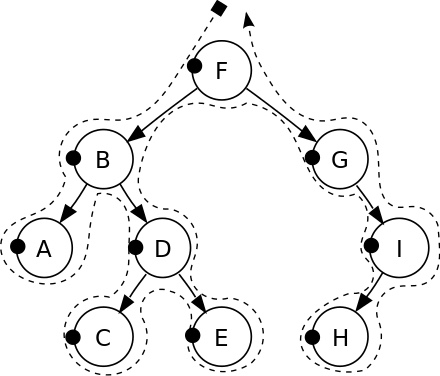Tree Traversal
树的遍历是大部分树题型的基础。
常用的遍历树的方法有BFS和DFS,

这里会详细介绍3种DFS遍历树的方法:
pre-order, in-order和 post-order。
它们之间的区别就在于父节点的访问顺序,
pre-order先访问父节点再访问左子树,最后到右子树。
图中pre-order: F, B, A, D, C, E, G, I, H
pre-order排列的第一个元素就是树的root
in-order先访问左子树,再访问父节点,最后到右子树。
图中in-order: A, B, C, D, E, F, G, H, I
in-order排列的左子树永远在parent左边,而右子树永远在parent右边
post-order先访问左子树,再访问右子树,最后才访问父节点。
图中post-order: A, C, E, D, B, H, I, G, F
post-order的最后一个元素就是树的root
任何时候只要知道树的三种排列中的两种,就能还原出一棵unique的树。
Implementation
class TreeNode {
int val;
TreeNode left;
TreeNode right;
}
input:
TreeNode root
output:
//print nodes
pre-order traversal:
public void preorder(TreeNode root) {
if(root == null) return;
System.out.print(root.val + “ “); //先访问根节点
preorder(root.left); //再访问左子树
preorder(root.right); //最后访问右子树
}
in-order traversal:
public void inorder(TreeNode root) {
if(root == null) return;
inorder(root.left); //先访问左子树
System.out.print(root.val + “ “); //再访问根节点
inorder(root.right); //最后访问右子树
}
post-order traversal:
public void preorder(TreeNode root) {
if(root == null) return;
postorder(root.left); //先访问左子树
postorder(root.right); //再访问右子树
System.out.print(root.val + “ “); //最后访问根节点
}
相关真题:
Recover binary search tree given the in-order array
Tree serialization
Find kith smallest element in binary search tree
Maximum path sum of tree
Get one-to-one training from Google Facebook engineers
Top-notch Professionals
Learn from Facebook and Google senior engineers interviewed 100+ candidates.
Most recent interview questions and system design topics gathered from aonecode alumnus.
One-to-one online classes. Get feedbacks from real interviewers.
Customized Private Class
Already a coding expert? - Advance straight to hard interview topics of your interest.
New to the ground? - Develop basic coding skills with your own designated mentor.
Days before interview? - Focus on most important problems in target company question bank.



